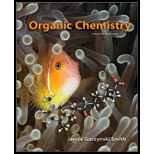
Concept explainers
(a)
Interpretation: Hybridization of each carbon atom in benzene is to be stated.
Concept introduction: When two or more orbitals of equal energy intermix to form new orbitals of similar energy then it is known as hybridization and the orbitals that are formed as a result of intermixing are called hybrid orbitals.
(b)
Interpretation: Geometry around each carbon atom and the overall geometry of the benzene ring are to be stated.
Concept introduction: Geometry of an atom is determined by the sigma bonds, lone pairs present and the hybridization of that particular atom.
(c)
Interpretation: The diagram showing the orbitals used to join the carbon atoms in the ring is to be drawn.
Concept introduction: When two or more orbitals of equal energy intermix to form new orbitals of similar energy then it is known as hybridization and the orbitals that are formed as a result of intermixing are called hybrid orbitals. They can be
(d)
Interpretation: Second resonance structure of benzene is to be drawn.
Concept introduction: When two or more orbitals of equal energy intermix to form new orbitals of similar energy then it is known as hybridization and the orbitals that are formed as a result of intermixing are called hybrid orbitals. The delocalization of electrons results in the formation resonance structure.
(e)
Interpretation: The reason for the benzene and the other
Concept introduction: When two or more orbitals of equal energy intermix to form new orbitals of similar energy then it is known as hybridization and the orbitals that are formed as a result of intermixing are called hybrid orbitals. The delocalization of electrons results in the formation resonance structure.
Want to see the full answer?
Check out a sample textbook solution
Chapter 1 Solutions
Organic Chemistry - With Access (Looseleaf) (Custom)
- a model of each molecule shown above: Is the molecule in the left box the same moleculeas the molecule in the right box? Use your models to answer the question, and recall that...arrow_forwardIn HF , neither H nor F holds a full formal charge of +1 or 1 . Organic chemists represent apartial charge using the Greek letter delta () . On the electron density map of the molecule HF above, add a + to one atom and a to the other to indicate which way the bond is polarized.arrow_forwardCan you explain to me how do resonance hybrid and how to answer the question?arrow_forward
- The curved arrow notation is a powerful method used by organic chemists to show the movement of electrons not only in resonance structures, but also in chemical reactions. Since each curved arrow shows the movement of two electrons, following the curved arrows illustrates what bonds are broken and formed in a reaction. Consider the following reaction. Choose the correct image that shows the curved arrows to show the movement of electrons.arrow_forwardHow many σ and π bonds are in the following molecules? And what these σ and π bonds mean?arrow_forwardFor the molecule shown, what orbital is the lone pair in?arrow_forward
- Which of the given resonance structures (A, B,or C) contributes most to the resonance hybrid? Which contributes least?arrow_forwardWhich of the given resonance structures (A, B, or C) contributes most to the resonance hybrid? Which contributes least?arrow_forwardSolve correctly please. which one is more basic? draw a resonance structure (One structure is enough)arrow_forward
- Show, using a drawing, how the carbon in methanal is hybridized. What is the resulting geometry of the molecule? Show and label all orbitals involved in the bonds holding this molecule together.arrow_forwardexplain and answer the "why" please. also, what makes one axial and the other equatorial? and what does Keq have to do with it ?arrow_forwardwhy this molecule is Z?arrow_forward
 Organic Chemistry: A Guided InquiryChemistryISBN:9780618974122Author:Andrei StraumanisPublisher:Cengage Learning
Organic Chemistry: A Guided InquiryChemistryISBN:9780618974122Author:Andrei StraumanisPublisher:Cengage Learning Chemistry for Today: General, Organic, and Bioche...ChemistryISBN:9781305960060Author:Spencer L. Seager, Michael R. Slabaugh, Maren S. HansenPublisher:Cengage Learning
Chemistry for Today: General, Organic, and Bioche...ChemistryISBN:9781305960060Author:Spencer L. Seager, Michael R. Slabaugh, Maren S. HansenPublisher:Cengage Learning


